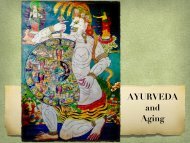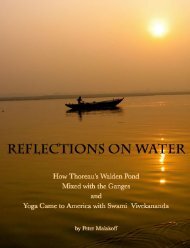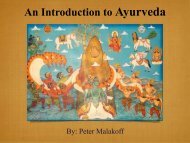How Thoreau's Walden Pond Mixed with the Ganges and Yoga Came to America with Swami Vivekananda
One early morning in 1846, during the coldest days of a New England winter, Henry David Thoreau looked out the window of his small cabin on Walden Pond and saw men cutting its ice into blocks. That ice was hauled by horse to a railroad that ran across the western edge of Walden Pond, packed into a boxcar, taken to Boston and loaded onto a clipper ship that sailed to Calcutta, India, arriving about four months later. Once there, that ice was purchased by grateful members of the East India Company. Thoreau had witnessed a small part of the global ice trade between New England and India that took place during the latter part of the nineteenth century. When Thoreau considered the ice trade, his vision sailed on metaphors far beyond the scope of business. The waters he imagined flowed both east and west and carried not just natural elements, but culture, religion and philosophy as well. He envisioned that after arriving in Calcutta, the New England ice of Walden Pond would eventually melt and run downhill where it would join with the sacred water of the Ganges. He wrote in Walden: "It appears that the sweltering inhabitants of Charleston and New Orleans, of Madras and Bombay and , drink at my well. In the morning I bathe my intellect in the stupendous and cosmogonal philosophy of the , since whose composition years of the gods have elapsed, and in comparison with which our modern world and its literature seem puny and trivial; and I doubt if that philosophy is not to be referred to a previous state of existence, so remote is its sublimity from our conceptions. I lay down the book [Bhagavad-Gita] and go to my well for water, and lo! there I meet the servant of the Bramin, priest of and and who still sits in his temple on the Ganges reading the , or dwells at the root of a tree with his crust and water jug. I meet his servant come to draw water for his master, and our buckets as it were grate together in the same well. The pure Walden water is mingled with the sacred water of the Ganges." This book tells the story of these waters . . .
One early morning in 1846, during the coldest days of a New England winter, Henry David Thoreau looked out the window of his small cabin on Walden Pond and saw men cutting its ice into blocks. That ice was hauled by horse to a railroad that ran across the western edge of Walden Pond, packed into a boxcar, taken to Boston and loaded onto a clipper ship that sailed to Calcutta, India, arriving about four months later. Once there, that ice was purchased by grateful members of the East India Company. Thoreau had witnessed a small part of the global ice trade between New England and India that took place during the latter part of the nineteenth century.
When Thoreau considered the ice trade, his vision sailed on metaphors far beyond the scope of business. The waters he imagined flowed both east and west and carried not just natural elements, but culture, religion and philosophy as well. He envisioned that after arriving in Calcutta, the New England ice of Walden Pond would eventually melt and run downhill where it would join with the sacred water of the Ganges. He wrote in Walden: "It appears that the sweltering inhabitants of Charleston and New Orleans, of Madras and Bombay and , drink at my well. In the morning I bathe my intellect in the stupendous and cosmogonal philosophy of the , since whose composition years of the gods have elapsed, and in comparison with which our modern world and its literature seem puny and trivial; and I doubt if that philosophy is not to be referred to a previous state of existence, so remote is its sublimity from our conceptions.
I lay down the book [Bhagavad-Gita] and go to my well for water, and lo! there I meet the servant of the Bramin, priest of and and who still sits in his temple on the Ganges reading the , or dwells at the root of a tree with his crust and water jug. I meet his servant come to draw water for his master, and our buckets as it were grate together in the same well. The pure Walden water is mingled with the sacred water of the Ganges."
This book tells the story of these waters . . .
Create successful ePaper yourself
Turn your PDF publications into a flip-book with our unique Google optimized e-Paper software.
Summary<br />
I live about 7500 ft up in <strong>the</strong> Himalayas, in a small valley on <strong>the</strong> sou<strong>the</strong>rn<br />
face of <strong>the</strong> Rohtang Pass in Himachal Pradesh, one of <strong>the</strong> nor<strong>the</strong>rn-most<br />
states of India. There I have a one-room cottage on <strong>the</strong> slope of a huge<br />
Deodar (Divine Tree) cedar-forested mountain, in a small meadow,<br />
surrounded by apple <strong>and</strong> apricot trees, up above a snow-melt, glacier-fed river<br />
called <strong>the</strong> Manalsu, which pours down in<strong>to</strong> <strong>the</strong> Beas River, that flows<br />
through <strong>the</strong> Kullu Valley. The Beas formed <strong>the</strong> boundary beyond which <strong>the</strong><br />
armies of Alex<strong>and</strong>er <strong>the</strong> Great refused <strong>to</strong> pass <strong>and</strong> marked <strong>the</strong> eastern-most<br />
extent of his eight-year world conquest. It runs down in<strong>to</strong> <strong>the</strong> Sutlej, which<br />
heads southwest, flowing all <strong>the</strong> way across nor<strong>the</strong>rn India, crossing <strong>the</strong><br />
Punjab in<strong>to</strong> Pakistan, where turning south it merges in<strong>to</strong> <strong>the</strong> Indus, emptying<br />
at last in<strong>to</strong> <strong>the</strong> Arabian Sea. (see map)<br />
If I follow a small path down across <strong>the</strong> meadow about 200 yards below<br />
my cottage, I can plunge my bare feet in<strong>to</strong> <strong>the</strong> cold, clear Manalsu. When I do<br />
so, I contact a river of water that <strong>to</strong>uches <strong>the</strong> Arabian Sea in ano<strong>the</strong>r country;<br />
that is what it was like <strong>to</strong> write this s<strong>to</strong>ry . . . no matter where I put my<br />
attention, in every character, event or idea, I <strong>to</strong>uched a great river, in which I<br />
recognized sources fur<strong>the</strong>r up in remote snow-covered mountains, that flowed<br />
in<strong>to</strong> far-away seas. It is a vast river of life, of whose currents I live mostly<br />
unaware. What I wrote about <strong>and</strong> what I saw was not what I expected <strong>to</strong> find.<br />
But that is how this tale came <strong>to</strong> be <strong>to</strong>ld <strong>and</strong> much of it was a surprise.<br />
I set out <strong>to</strong> write a s<strong>to</strong>ry about <strong>the</strong> mingling of <strong>the</strong> waters of <strong>Walden</strong> <strong>Pond</strong><br />
<strong>and</strong> <strong>the</strong> <strong>Ganges</strong>, <strong>and</strong> <strong>the</strong> return of those waters <strong>to</strong> New Engl<strong>and</strong>, thinking <strong>to</strong><br />
show how <strong>Yoga</strong> was brought <strong>to</strong> <strong>America</strong> by <strong>Swami</strong> Vivekan<strong>and</strong>a in 1893. I<br />
found many rivers poured in<strong>to</strong> this s<strong>to</strong>ry, before, during <strong>and</strong> after<br />
Vivekan<strong>and</strong>a’s arrival. Many people <strong>and</strong> ideas had prepared <strong>the</strong> ground for<br />
him <strong>and</strong>, of course, <strong>the</strong>re were <strong>the</strong> events <strong>and</strong> times that surrounded <strong>the</strong> tale<br />
<strong>to</strong>ld here.<br />
92


















